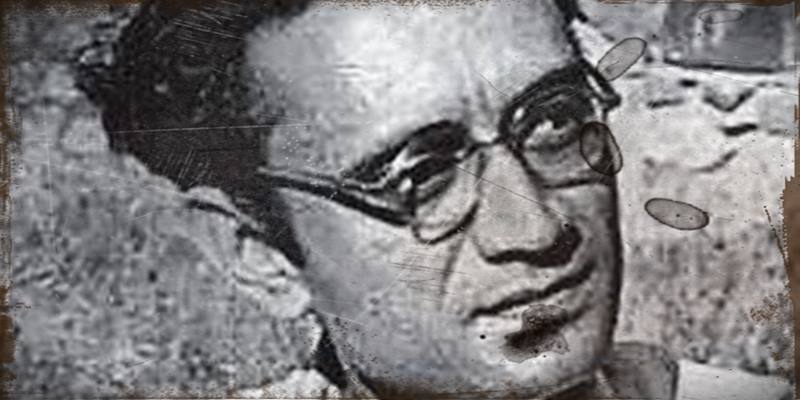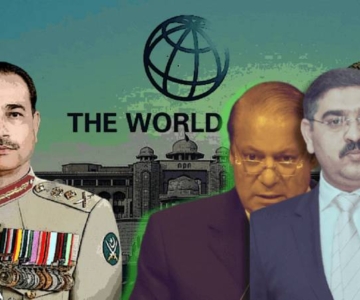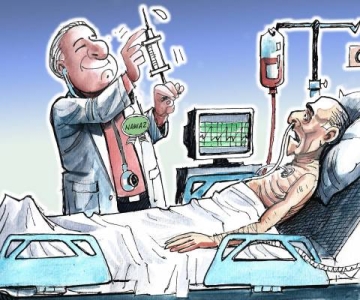After partition of India Saadat Hassan Manto arrived in Lahore sometime in early 1948. In Bombay his friends had tried to stop him from migrating to Pakistan because he was quite popular as a film writer and was making reasonably good money. Among his friends there were top actors and directors of that age-many of them Hindus-who were trying to prevail upon him to forget about migrating. They thought that he would be unhappy in Pakistan because the film industry of Lahore stood badly disrupted with the departure of Hindu film-makers and studio owners. But the law and order situation post-partition of British India was such that many Muslims felt insecure in India, just as many Hindus felt insecure in newly created Pakistan. That was the reason that Manto had already sent his family to Lahore and was keen to join them. Manto and his family were among the millions of Muslims who left present-day India for the newly created Muslim-majority nation of Pakistan.
Life in Lahore
Manto had at least one consolation. His nephew Hamid Jalal had already settled his family in a flat next to his own in Lakshmi Mansions near The main Mall. The complex was centrally located. From there every place of importance was at a stone’s throw. These flats were occupied by families of some of the people who were destined to become important in the intellectual and academic fields. Manto’s next door neighbour was his nephew Hamid Jalal who later became an important mediaman. In another flat, lived Professor G M Asar who taught Urdu at Government College, Lahore. Hailing from Madras, he wrote and spoke excellent English as well. Then there was Malik Meraj Khalid who was to play an important role in the politics of Pakistan. Writer Mustansar Hussain Tarar’s family also lived in one of the flats there after shifting from Gowalmandi, though Tarar’s presence cannot be referred to as a contribution to literary ambience as Tarar was just an adolescent at that time and hadn’t even started to write.. Thus when Manto arrived in Lahore from Bombay he found an intellectual atmosphere around him. His only problem was how to cater for his family. Sadly for him, Lahore of that period did not have many opportunities to offer.
Literary beginnings
After the writers who had migrated from various Indian cities settled in Lahore, they started their literary activities. Soon Lahore saw a number of newspapers and periodicals appearing. Manto initially wrote for some literary magazines. These were the days when his controversial stories like Khol Do and Thanda Gosht created a furor among the conservatives. People like Choudhry Muhammad Hussain played a role in banning and prosecuting the writer as well as the publishers and editors of the magazines that printed his stories. Among the editors were such amiable literary figures as Ahmad Nadeem Qasmi, Hajira Masroor and Arif Abdul Matin. Soon the publishers who were more interested in commercial aspects of their ventures, slammed their doors shut to Manto’s writings. He, therefore, started contributing stories to the literary supplements of some newspapers. Even this practice could not go on for long. Masood Ashar who was then editing the literary page of “Daily Ehsan” published some of his stories but the conservative owner of the paper soon asked him to refrain from the practice.
Newspapers
During those days, Manto also tried his hand at newspaper column writing. he started off with writing under the title Chashm-e-Rozan for daily Maghribi Pakistan on the insistence of his friends of Bombay days Ehsan BA and Murtaza Jillani who were editing that paper. But after a few columns one day the space appeared blank under the column saying that due to his indisposition Manto couldn’t write the column. Actually Manto was not indisposed, the owner was not favourably disposed to some of the sentences in the column.
The only paper that published Manto’s articles regularly for quite some time was “Daily Afaq”, for which he wrote some of his well known sketches. These sketches were later collected in his book Ganjay Farishtay(Bald Angels). The sketches include those of famous actors and actresses like Ashok Kumar, Shyam, Nargis, Noor Jehan and Naseem (mother of Saira Banu). He also wrote about some literary figures like Meera Ji, Hashar Kashmiri and Ismat Chughtai. Manto’s sketch of Quaid-e-Azam Muhammad Ali Jinnah was also first published in Afaq under the title Mera Sahib. It was based on an interview with Haneef Azad, Qauid-e-Azam’s driver of Bombay days who after leaving his job as driver became a well known actor. The article included some of the remarks related to the incident when Dina Jinnah married Wadia. Later when the sketch was included in the book these lines were omitted.
Manto created a new tell-all style of writing sketches. He would mince no words, writing whatever he saw. “I have no camera which could wash out the small pox marks from Hashar Kashmiri’s face or change the obscene invectives uttered by him in his flowery style,” he wrote.
Literary circles
Manto once tried to present the sketch of Mulana Chiragh Hasan Hasrat in a literary gathering organized in YMCA Hall Lahore to celebrate the Maulana’s recovery from heart attack. The sketch entitled Bail Aur Kutta was written in his characteristic style exposing some aspects of Maulana’s life. The presiding dignitary stopped him from reading the article and ordered him to leave the rostrum. Manto, however, was in ‘high spirits’. He refused to oblige and squatted on the floor, and was with difficulty prevailed upon by his wife, Safia, to leave the stage.
Financial troubles
Those days Manto was writing indiscriminately in order to provide for his family and be able to drink every evening. For everything he wrote, he would demand cash in advance. In later days, he started writing for magazines like Director. He would go to its office, ask for pen and paper, write his article, collect the remuneration and go away. This Manto was different from the one who arrived in Lahore in 1948.
The Manto in 1950 had a glowing Kashmiri complexion and a thick crop of long brown hair on his head. He was wearing a light brown gabardine shirwanee with a silken trousers and saleem shahi shoes. He came to Government College, Lahore to read his article How Do I Write a Story.
A changed man
But the necessity to earn his livelihood consumed him very fast. In a few years, his complexion became pale and his hair turned grey. We saw him reading his story Toba Tek Singh at YMCA Hall at the annual meeting of Halqa-e-Arbab-e-Zauq. He looked older than his years wearing an overcoat with collars turned up. The big eyes that darted out of the thick-rimmed glasses looked pale and yellow. But he read his story in his usual dramatic style and when he finished reading it there was pin drop silence in the hall and there were tears in everyone’s eyes.
In later days, though Manto appeared in the Pak Tea House and other literary functions regularly but he seemed to be in great stress. Earlier, he was known for his witty remarks in literary gatherings. However, in later days he would present his writings in literary meetings but would not tolerate any criticism. He had become extremely touchy and would shout back at his critics. There were days when he was welcomed everywhere and literary organisations clamoured for his participation in their meetings. But then came the days when people started avoiding him because he would not hesitate from borrowing money from them.
His famous literary works
Manto lived in Laxmi Mansion, The Mall Lahore for seven years. For him those years were full of a continuous struggle for his survival. In return, he gave some of his best writings to the literary world. It was in Lahore that he wrote his masterpieces that include Thanda Gosht, Khol Do, Toba Tek Singh, Iss Manjdhar Mein, Mozalle, Babu Gopi Nath. Some of his characters became legendary.
Death
Simultaneously he had embarked on a journey of self-destruction. The substandard alcohol that he consumed destroyed his liver and in the winter of 1955 he fell victim to liver cirrhosis. During all these years in Lahore he waited for the good old days to return, never to find them again.He was 42 years old at the time of his death. He was survived by his wife Safiyah and three daughters.
On January 18, 2005, the fiftieth anniversary of his death, Manto was commemorated on a Pakistani postage stamp.
Manto collection (Books)
Atishparay -1936 (Nuggets Of Fire)
Manto Ke Afsanay (Stories of Manto)-1940
Dhuan (Smoke) -1941
Afsane Aur Dramay (Fiction and Drama)-1943
Lazzat-e-Sang-1948 (The Taste Of Rock)
Siyah Hashiye-1948 (Black Borders)
Badshahat Ka Khatimah (The End of Kingship)-1950
Khali Botlein (Empty Bottles)-1950
Nimrud Ki Khudai (Nimrod The God)-1950
Thanda Gosht (Cold Meat)-1950
Yazid-1951
Pardey Ke Peechhey (Behind The Curtains)-1953
Sarak Ke Kinarey (By the Roadside)- 1953
Baghair Unwan Ke (Without a Title)-1954
Baghair Ijazit (Without Permission)-1955
Burquey-1955
Phunduney-1955 (Tassles)
Sarkandon Ke Peechhey-1955 (Behind The Reeds)
Shaiytan (Satan)-1955
Shikari Auratein – 1955 (Women Of Prey)
Ratti, Masha, Tolah-1956
Kaali Shalwar (Black Pants)-1961
Manto Ki Behtareen Kahanian (Best Stories of Manto)-1963



